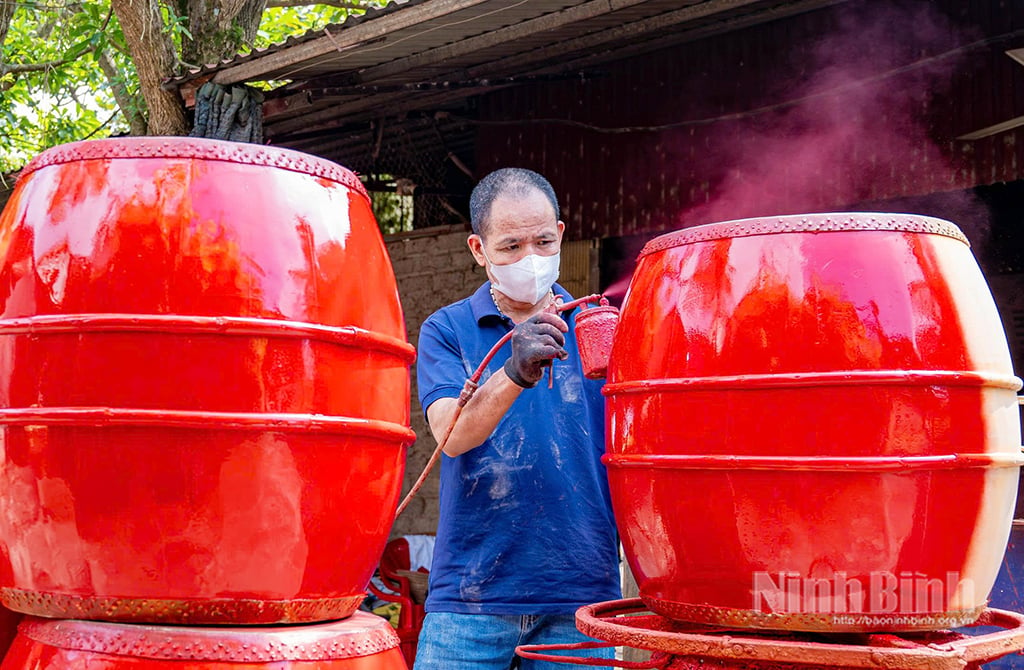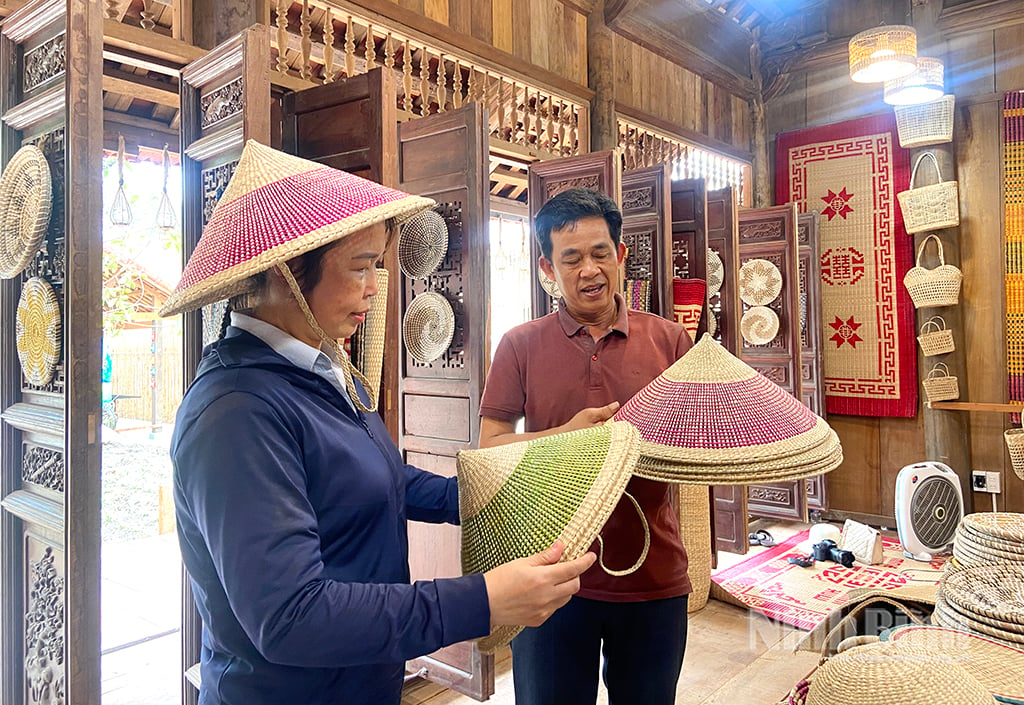
Convergence of craft village quintessence
The merger of the three provinces of Ha Nam, Nam Dinh and Ninh Binh into the new Ninh Binh province is an important turning point, opening up development opportunities for the dynamic sub-region in the South of the Red River Delta. In particular, the possession of a large number of craft villages with unique brands and values will promote socio-economic development. According to preliminary statistics, the province currently has over 250 craft villages, concentrated in many different industries such as agricultural, forestry and fishery processing; handicraft production; production of wooden products, rattan and bamboo, ceramics, textiles, embroidery, mechanics; and ornamental plants.
Prominent among them are craft villages such as An Hoa embroidery village; Nha Xa silk weaving village; Ngoc Dong commune's bamboo and rattan weaving village; Doi Tam drums..., in the old Ha Nam province; Tong Xa bronze casting village, La Xuyen wood carving, Cat Dang lacquerware, Vinh Hao bamboo and rattan weaving, Ban Thach water puppetry, Giap Nhat turban making... in the old Nam Dinh province or famous craft villages in the old Ninh Binh such as Ninh Van stone craft, Ninh Hai lace embroidery, Bo Bat pottery, Kim Son sedge... Many craft villages have been recognized as national intangible cultural heritages such as Ninh Hai lace embroidery, Ninh Van stone craft, Cat Dang lacquerware, Doi Tam drums, Nha Xa silk weaving...
As a traditional craft with a history of thousands of years, like many other crafts and villages, the drum craft of Doi Tam, Tien Son ward, Ninh Binh province, was once at risk of being lost due to a small consumption market. However, in recent years, Doi Tam drum village has made breakthrough developments with many creative products, suitable for the needs and tastes of customers. In addition to drum products with diverse sizes and designs, the craftsmen here also produce products for export to Asian and European countries such as wine barrels, bathtubs, and foot baths.
Mr. Pham Tri Trong, Chairman of the Doi Tam Drum Production and Trading Association, said: Currently, Doi Tam drum craft village has about 50 production workshops, creating stable jobs for thousands of local workers, with an income of 7 to 15 million VND/person/month. We are proud to have maintained and developed the traditional craft for many generations, but we are always concerned about output, brand promotion as well as market expansion potential.
“The merger of the provinces opens up new opportunities for craft villages to develop both in breadth and depth. With a larger scale and a larger population, the domestic consumption market will expand. On the other hand, when trade connections between regions in the province are improved, Doi Tam drum village products will easily access major tourist centers such as Trang An, Tam Chuc, Phat Diem..., thereby enhancing the ability to consume products through tourism and culture,” Mr. Trong expected.

Creative space of cultural industry
Each craft village in Ninh Binh has its own identity, creating unique and sophisticated products. This is also a valuable human tourism resource, of great significance in developing the local cultural industry, promoting the development of many industries and fields such as fine arts, exhibitions, handicrafts, architecture, especially cultural tourism.
Ms. Duong Thi Thanh, Chairwoman of Ninh Binh Tourism Association, said that tourism and craft villages are two fields with a close and dialectical relationship. Craft villages provide tourism with unique cultural values, gift products with strong identity, while tourism opens the way to bring craft villages closer to domestic and foreign tourists, contributing to product consumption, creating more livelihoods for local people.
According to Ms. Thanh, in the past time, many tours associated with visiting and experiencing craft villages have been built in the province and have initially shown their effectiveness. For example, tours to explore Ninh Van stone carving village, Bo Bat pottery village, Van Lam embroidery village, or tours to Doi Tam drum village in Tam Chuc tourist area, Nha Xa silk weaving in Lanh Giang temple... These models have shown the great potential of connecting tourism and craft villages.
“After the province merger, with the expansion of space and cultural diversity and traditional crafts among the three old provinces, I believe this is the golden time to promote the development of tourism products associated with craft villages. The Association will actively coordinate with travel agencies, localities and artisans to design more attractive experiential tours, improve service quality, train tour guides who are knowledgeable about craft village culture and connect with the market,” Ms. Thanh added.
Mr. Trinh Quoc Dat, Chairman of the Vietnam Craft Village Association, emphasized: the merger opens up great opportunities to contribute to the preservation and development of traditional craft villages. However, Ninh Binh craft villages, like other craft villages across the country, are currently facing many challenges such as: requiring innovative, creative, and timely management thinking, especially for commune-level officials when operating a two-level local government; unsynchronized infrastructure; difficult transportation, and lack of connectivity in warehouses and logistics.
Therefore, in order for craft villages to develop their potential and strengths and promote the development of cultural industry, Ninh Binh needs to build a cultural value chain for craft village products. Each product not only needs to be of good quality, but also needs to tell a story about history, people and culture.
In addition, it is necessary to promote digital transformation and design innovation. Strengthen the connection between artisans and young designers and creative start-ups to improve designs and diversify products without losing the traditional spirit. It is necessary to create craft village models, cultural destinations, build craft demonstration spaces, experience areas, craft village night markets, craft learning tours, workshops for international tourists...
In the development flow of cultural industry, traditional craft villages are not only places to preserve national cultural memories, but also valuable resources to promote local economic development. Effectively exploiting new development spaces, promoting regional connectivity, and investing in depth in creativity and promoting craft village products will help craft villages not only "revive" but also have more room for development, becoming important creative spaces of the cultural industry.
Source: https://baoninhbinh.org.vn/lang-nghe-ninh-binh-trong-khong-gian-phat-trien-moi-976698.htm






































































































Comment (0)